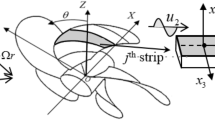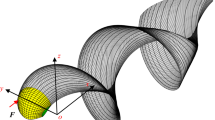Abstract
The aim of this work is to analyze the hydroacoustic behavior of a marine propeller through the acoustic analogy and to test the versatility and effectiveness of this approach in dealing with the many (and relatively unexplored) issues concerning the underwater noise and its numerical prediction. In particular, a propeller in a noncavitating open water condition is examined here by coupling a Reynolds averaged Navier–Stokes hydrodynamic solver to a hydroacoustic code implementing different resolution forms of the Ffowcs Williams–Hawkings (FWH) equation. The numerical results suggest that unlike the analogous aeronautical problem, where the role played by the nonlinear quadrupole sources is known to be relevant just at high transonic or supersonic regime, the pressure field underwater seems to be significantly affected by the flow nonlinearities, while the contribution from the linear terms (the thickness and loading noise components) is dominant only in a spatially very limited region. Then, contrary to popular belief and regardless of the low blade rotational speed, a reliable hydroacoustic analysis of a marine propeller cannot put aside the contribution of the nonlinear noise sources represented by the turbulence and vorticity three-dimensional fields and requires the computation of the FWH quadrupole source terms.






















Similar content being viewed by others
References
Ffowcs Williams JE, Hawkings DL (1969) Sound generation by turbulence and surfaces in arbitrary motion. Philos Trans R Soc 264(A1151):321–342
Seol H, Jung B, Suh JC, Lee S (2001) Prediction on non-cavitating underwater propeller noise. J Sound Vib 257(1):131–156
Farassat F (1981) Linear acoustic formulas for calculation of rotating blade noise. AIAA J 19(9):1122–1130
Seol H, Suh JC, Lee S (2005) Development of hybrid method for the prediction of underwater propeller noise. J Sound Vib 288(1/2):345–360
Testa C, Ianniello S, Salvatore F, Gennaretti M (2008) Numerical approaches for hydroacoustic analysis of marine propellers. J Ship Res 52(1):57–70
Salvatore F, Ianniello S (2003) Preliminary results on acoustic modelling of cavitating propellers. Comput Mech 32(4–6):291–300
Salvatore F, Testa C, Ianniello S, Pereira F (2006) Theoretical modelling of unsteady cavitation and induced noise. In: 6th international symposium on cavitation, CAV 2006, Wageningen, The Netherlands
Testa C (2008) Acoustic formulations for aeronautical and naval rotorcraft noise prediction based on the Ffwocs Williams-Hawkings Equation. Ph.D Thesis, Delft University of Technology. ISBN 978-90-8559-358-4
Salvatore F, Testa C, Greco L (2009) Coupled hydrodynamics-hydroacoustics BEM modelling of marine propellers operating in a Wakefield. In: 1st international symposium on marine propulsors, SMP09, Trondheim, Norway
Ianniello S (2007) New perspectives in the use of the Ffowcs Williams-Hawkings equation for aeroacoustic analysis of rotating blades. J Fluid Mech 570:79–127
Spalart PR, Allmaras SR (1994) A one-equation turbulence model for aerodynamic flows. La Recherche Aérospatiale 1:5–21
Merkle CL, Athavale M (1987) Time-accurate unsteady incompressible flow algorithm based on artificially compressibility. AIAA paper, 87-1137D
Chorin A (1967) A numerical method for solving incompressible viscous flow problems. J Comput Phys 2:12–26
Di Mascio A, Broglia R, Muscari R (2007) On the application of the single-phase level set method to naval hydrodynamic flows. Comput Fluids 36:868–886
Di Mascio A, Broglia R, Muscari R (2009) Prediction of hydrodynamic coefficients of ship hulls by high-order Godunov-type methods. J Marine Sci Technol 14:19–29
Beam RM, Warming RF (1978) An implicit factored scheme for the compressible Navier-Stokes equations. AIAA J 16:393–402
Favini B, Broglia R, Di Mascio A (1996) Multi-grid acceleration of second order ENO schemes from low subsonic to high supersonic flows. Int J Numer Methods Fluids 23:589–606
Muscari R, Di Mascio A (2005) Simulation of the flow around complex hull geometries by an overlapping grid approach. In: Proceedings 5-th Osaka colloquium on advanced research on ship viscous flow and hull form design by EFD and CFD approaches, Osaka, Japan
Muscari R, Broglia R, Di Mascio A (2006) An overlapping grids approach for moving bodies problems. In: Proceedings of the 16-th international offshore and polar engineering conference (ISOPE 2006), San Francisco, California, USA
Farassat F (1975) Theory of noise generation from moving bodies with an application to helicopter rotors. NASA, TR-R-451
Di Francescantonio P (1997) A new boundary integral formulation for the prediction of sound radiation. J Sound Vib 202(4):491–509
Roache PJ (1997) Quantification of uncertainty in computational fluid dynamics. Annu Rev Fluid Mech 29:123–160
Pope SB (2000) Turbulent flows. Cambridge University Press, Cambridge
Wang M, Freund JB, Lele SK (2006) Computational prediction of flow-generated sound. Annu Rev Fluid Mech 38:483–512
Acknowledgments
This work was developed within the frame of the collaborative Research project SILENV (Ships oriented Innovative soLutions to rEduce Noise & Vibrations, funded by the EU in the Call FP7-SST-2008-RTD-1. Grant Agreement SCP8-GA-2009-234182) and partially funded by the Italian Ministry of Education, University and Research through the research project RITMARE.
Author information
Authors and Affiliations
Corresponding author
About this article
Cite this article
Ianniello, S., Muscari, R. & Di Mascio, A. Ship underwater noise assessment by the acoustic analogy. Part I: nonlinear analysis of a marine propeller in a uniform flow. J Mar Sci Technol 18, 547–570 (2013). https://doi.org/10.1007/s00773-013-0227-0
Received:
Accepted:
Published:
Issue Date:
DOI: https://doi.org/10.1007/s00773-013-0227-0




